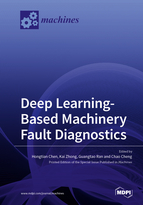Deep Learning-Based Machinery Fault Diagnostics
A special issue of Machines (ISSN 2075-1702). This special issue belongs to the section "Machines Testing and Maintenance".
Deadline for manuscript submissions: closed (28 May 2022) | Viewed by 31473
Special Issue Editors
Interests: fault detection and diagnosis; high-speed trains; data mining and analytics; machine learning; quantum computation
Special Issues, Collections and Topics in MDPI journals
Interests: deep learning; machinery fault diagnosis; graph neural networks
Interests: learning-based control; fault diagnosis; event-based control
Interests: fault diagnosis; distributed systems; information processing
Special Issues, Collections and Topics in MDPI journals
Special Issue Information
Dear Colleagues,
Papers are sought that address innovative solutions to the development and use of deep learning techniques for the monitoring and/or diagnosis of faults in machinery equipment for the purpose of advancing fault diagnosis science, and its applications in various machinery.
The scope of these papers may encompass (1) theory, methodology, and practice of deep learning; (2) analysis, representation, display, and preservation of information obtained from a set of machinery to carry out fault diagnosis and operating condition monitoring; and (3) scientific and technical support for the establishment and maintenance of technical standards in the field of machinery fault diagnosis.
In this Special Issue, original research articles and reviews are welcome. We look forward to receiving your contributions.
Dr. Hongtian Chen
Dr. Kai Zhong
Dr. Guangtao Ran
Prof. Dr. Chao Cheng
Guest Editors
Manuscript Submission Information
Manuscripts should be submitted online at www.mdpi.com by registering and logging in to this website. Once you are registered, click here to go to the submission form. Manuscripts can be submitted until the deadline. All submissions that pass pre-check are peer-reviewed. Accepted papers will be published continuously in the journal (as soon as accepted) and will be listed together on the special issue website. Research articles, review articles as well as short communications are invited. For planned papers, a title and short abstract (about 100 words) can be sent to the Editorial Office for announcement on this website.
Submitted manuscripts should not have been published previously, nor be under consideration for publication elsewhere (except conference proceedings papers). All manuscripts are thoroughly refereed through a single-blind peer-review process. A guide for authors and other relevant information for submission of manuscripts is available on the Instructions for Authors page. Machines is an international peer-reviewed open access monthly journal published by MDPI.
Please visit the Instructions for Authors page before submitting a manuscript. The Article Processing Charge (APC) for publication in this open access journal is 2400 CHF (Swiss Francs). Submitted papers should be well formatted and use good English. Authors may use MDPI's English editing service prior to publication or during author revisions.
Keywords
- deep learning
- signal processing
- fault diagnosis
- operating condition monitoring
- machinery equipment








